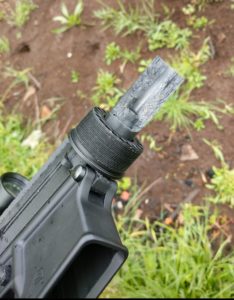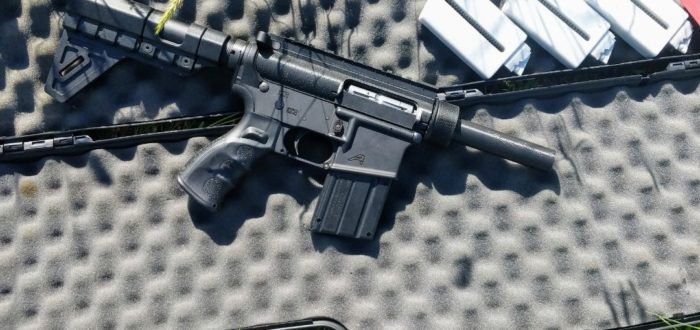G. Hays
Following on from the release of the FGC-9 (see ARES Research Report No. 8 for details), development in the area of 3D-printed firearms components has been rapidly progressing. Recently, this was expressed in the testing of another novel semi-automatic firearm, in this case a .22 LR AR-style ‘pistol’ featuring a barrel entirely printed from polylactic acid polymer (PLA). Another design from the developers at Deterrence Dispensed, the firearm makes extensive use of printed components, including the upper receiver (the lower receiver having already been successfully tested) and the magazine. A .22 LR conversion bolt for the AR-15 platform was used in these tests.
According to one tester, the fully-printed barrel was able to withstand 65 rounds of .22 LR being fired through it before failing. Reportedly, the last 45 rounds were fired in rapid succession. Two barrel lengths—3.2 in (81 mm) and 5.2 in (132 mm)—were tested, apparently yielding average velocities of 949.5 fps (289.4 m/s) and 1,009.5 fps (308.7 m/s), respectively.

The rifling (forming an integral part of the design of the printed barrel) apparently remained intact for the first 20 shots. It is likely that the application of any of a range of existing techniques—such as the method of fibreglass reinforcing applied to the 3D-printed ‘Plastikov’ AK-type lower receiver—would result in a much more durable barrel. ‘Hybrid’ designs, incorporating non-firearms metallic components, such as supporting the barrel with lengths of steel brake-line tube, would also be applicable to this type of design.

Whilst the effectiveness and durability of entirely-polymer rifling remains a trickier challenge to overcome, the application of alternative craft-production techniques (most notably electrochemical machining, or ECM) already provide viable alternatives to the DIY arms producer. With the successes of this early foray into 3D printing rifled, polymer barrels, it seems likely that inexpensive entirely (or nearly-entirely) printed semi-automatic pistols are on the horizon. Chambered for the .22 LR—the most commonly available rifle cartridge in the world—the potential for the proliferation of such designs could be high.
Remember, all arms and munitions are dangerous. Treat all firearms as if they are loaded, and all munitions as if they are live, until you have personally confirmed otherwise. If you do not have specialist knowledge, never assume that arms or munitions are safe to handle until they have been inspected by a subject matter specialist. You should not approach, handle, move, operate, or modify arms and munitions unless explicitly trained to do so. If you encounter any unexploded ordnance (UXO) or explosive remnants of war (ERW), always remember the ‘ARMS’ acronym:
AVOID the area
RECORD all relevant information
MARK the area from a safe distance to warn others
SEEK assistance from the relevant authorities


One thought on “Polymer 3D-printed barrel successfully tested”